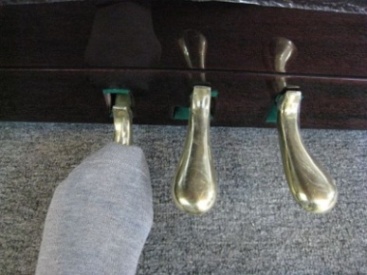
A Shifty Character
“A Shift Character” likely raises a specter of juicy details of a deal gone sour. Maybe you said to yourself, “Finally, some real dirt to use!” I hate to be the proverbial stick in the mud, but this is an article about the shift pedal on a grand piano, its many uses, and how it should be maintained.
On Saturday, September 26, 2020 I tuned in to the Piano Tech Radio Hour, a weekly presentation for piano technicians by Eathan Janney and his Piano Technician Masterclasses. Each week, we have guests that discuss the state of the piano market, technical issues, and other topics of interest to those who work on these magnificent instruments. This particular episode featured Eric Johnson, a piano technician working in and around Fairfield County Connecticut and Charleston South Carolina and his friend, Frederic Chiu. Maestro Chiu has taught at a number of universities, is an acclaimed author, a touring concert pianist and recording artist, and still finds time to meet with a bunch of piano techno geeks on a Saturday. It is largely his work on which I will focus during this article.
Location, Location, Location
First, let us look at the shift pedal, where it is located, and some of its functions. The piano lyre is in the middle of the front of the piano. Its exact placement is dependent on a number of design elements. It is typically attached to the underside of the piano and while it hangs down, it does not touch the floor. In this location, the musician can access and manipulate the pedals quite easily from a sitting position. For many years, there were only two pedals, the shift pedal on the left and the sustain pedal on the right. If your grand piano has three pedals, it is likely the center pedal is for creating a sostenuto effect when called for by the music and/or musician.
The function of the shift pedal is to change the character and tone produced by the piano. For many musicians, it is a binary switch making the piano sound and play softer and while it can serve this function, it has many other uses such as Clean and Clear, Sha Boom, Rounded, and others.
History
The shift pedal (una corda for the technical geeks) is also known as the soft pedal and was introduced by Bartolomeo Cristofori as a way to modify the tone of his invention, the pianoforte, later shortened to just piano. Soon after its invention, the ‘soft pedal’ was adopted by most of the piano manufacturers of the time. Its function during this time was binary, it was either on, shifting the piano action to the right causing the hammer to strike the string on the hammer’s softest part, or it was off. This shifting of the piano’s action is what earned the pedal the name sift pedal and is still used by many pianists in this binary fashion (on/off) today, some 300 years after the piano’s invention.
By the late eighteen hundreds, manufacturers were using three strings per note which changed the function of the una corda or shift pedal. While there is no standard for the shift pedal’s function, it is most often adjusted to shift the action to the right so that only two of the three strings are played when the hammer strikes. This has the effect of changing the tone color of the piano and gives the sound an added dimension for the pianist to use. Using the binary approach, a musician can change the color of the sound by fully depressing the una corda or they can immediately return to the original sound by letting the pedal return to its home position. However, this leaves quite a bit of room in-between to only partial depress the pedal. And what, if any, is the effect of this action on the tone of the piano?
A Many Splendor Thing
Maestro Frederic Chiu has studied both the history of the una corda pedal and the markings found in a number of classical works. These markings seem to indicate there is more to the use of this pedal than a binary switch. According to Mr. Chiu there are seven positions the una corda can achieve, each with its own sound and impact on the tone.
Clean and Clear (Defined)
The first or neutral position is where the action is at rest and there is no shift pedal involved. This should give the cleanest and clearest tone for each note on the piano. Because the strings are made from steel and the hammers from wool, the hammer felt develops grooves where the strings touch. These grooves are, in reality, compressed wool that makes the tone brighter. In modern day pianos, it is important for the piano to be able to sound bright and clear. Think of all the recordings that would suffer if the piano was dull and boring. This bold, bright sound was extensively used by the many composers from the Classical period.
Sha Boom (Zing)
In the second position the three strings are struck by the vertical part of the hammer with a soft, brushing effect. The vertical part of the hammer has been created by the steel strings cutting into the soft felt. By shifting the hammers via the shift pedal to this position, the musician can create a softer sound that ends up with a bump at the end, therefore the name ‘Sha Boom’.
Rounded (Position 3)
In the third position all three strings are struck by the soft part of the hammer, usually located just before the peaks of the hammer between the string groves. Consistent and diligent voicing will need to be maintained for this to be a useful pedal position.
Tubby
This fourth position is located on the peaks of the hammer between the string grooves. In the fourth position all three strings strike the softest part of the hammer creating a tone full of middle to lower partials and sounding quite different from position 1.
Rounded (Position 5)
Position five can be difficult to locate but provides a similar sound to position three though a bit less in volume. There are a number of speculations as to why this occurs. None are any better than the impact of the third string is getting closer to the hammer shoulder where there is less support and often looser wool fibers.
Sha Boom 2 (Zing 2)
Sha Boom 2 is the sixth position and should be similar to position 2 with less volume. Again, the speculated reason is that the third string is close to the shoulder. In some pianos only two strings will be struck. Others will allow for this sound while all three strings are struck. The tone should be even softer while retaining a brushing effect.
Soft
The seventh and final position should see only strings one and two struck by the hammer using the existing hammer groves for strings two and three. this technique should give a well defined and clear sound albeit softer.
So, now that we know the seven position definitions as given by Maestro Chui, what can we do we do with them? Before launching into a long list of titles, Dr. Chui says that most pianos are incapable of all seven positions but every grand should be capable of the three major positions, one, four, and seven. I would agree with this assessment. Many grand piano designs, materials, and construction will not allow for the extremely tight tolerances required for seven positions.
Repertoire
From my limited experience I see a number of excellent teachers who use the shift pedal as a binary switch. This view of the shift pedal would limit it’s usage and therefore the passages where it would be applied. Dr. Chui has studied the lives and writings of a number of composers, especially those who wrote for the piano, and has a much larger list of pieces than most teachers. For example, Chopin’s Etude Opus #25 would seem to score for a technique that no longer exists. However, if we can find and use the second position of the shift pedal, it is possible to create a shimmering effect with the lead voice with little impact to the mezzo forte loudness marking. Necessary? You will have to be the judge.
Maintenance
This level of surgical maneuvering and manipulation will take many hours of focused and intense practice. But that is life of a dedicated pianist; concentrated, focused, purposeful practice.
It is equally obvious that the hammers will need to be maintained at a very high level and often. An hour long concert filled with Rachmaninov or other equally vigorous music will likely change the shift pedal palette. A regular tuning that includes some voicing will keep your piano in practice shape but it will take a skilled technician some time to prepare a concert piano for Dr. Chui and his extended use of the shift pedal.
Final Thoughts
I have been playing piano music from some fifty-five years and was fortunate to have great pianists as teachers. It has only been in the last two years that I discovered this extended use of the shift pedal. Dr. Chui says that less than ten percent of the teachers will know about these techniques and a subset of that will teach their students to recognize and use them in their playing. I would add that less than ten percent of the piano technicians will know about these techniques and a subset of that number will have the interest, dedication, or developed skills to address this level of refinement.
Is it necessary? Do I need to study and learn more? If I could offer any advise it would be to attack this shift pedal technique with a vengeance. Learn what you can and practice even more. It will be hard at first and you will likely be bad at it. (Even Mozart had to practice.) The rewards are comments like, “you play with such sensitivity” or “I could only dream of making my Chopin sound like that.”
If you would like to schedule a service call to have your piano evaluated for this level of service, call Campbell Piano Shop at +1 (719) 351-2766.
